|
Here are all the paintings of MASSYS, Quentin 01
| ID |
Painting |
Oil Pantings, Sorted from A to Z |
Painting Description |
| 51047 |
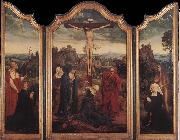 |
Christ on the Cross with Donors |
c. 1520 Oil on wood,
156 x 92,7 cm |
| 8104 |
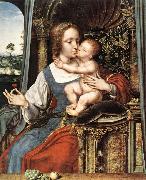 |
Christ on the Cross with Donors (detail) sg |
c. 1520
Oil on wood
Museum Mayer van den Bergh, Antwerp |
| 43551 |
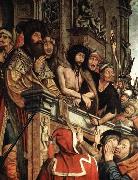 |
Ecce Homo |
c. 1515
Oil on panel
160 x 120 cm |
| 8105 |
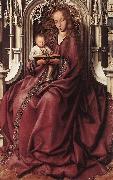 |
Ecce Homo dhy |
c. 1515
Oil on panel, 160 x 120 cm
Museo del Prado, Madrid |
| 8106 |
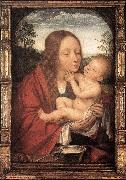 |
Entombment dh |
c. 1525
Wood
Stedelijke Musea, Leuven |
| 32400 |
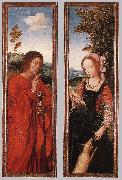 |
John the Baptist and St Agnes |
c. 1520
Oil on oak, 48 x 13,3 cm |
| 33534 |
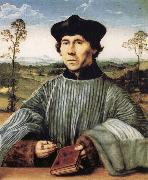 |
Portrait of a Canon |
mk86
c.1510-1520
Oil on wood
60x73cm
Vaduz
|
| 8111 |
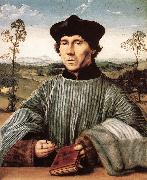 |
Portrait of a Canon atuy |
1510s
Oil on wood, 60 x 73 cm
Collection of the Prince of Lichtenstein, Vaduz |
| 8110 |
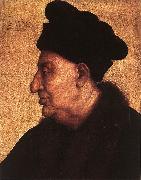 |
Portrait of an Old Man sg |
c. 1517
Oil on wood, 48 x 37 cm
Mus??e Jacquemart-Andr??, Paris |
| 8113 |
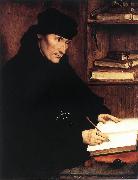 |
Portrait of Erasmus of Rotterdam sg |
1517
Oil on panel, transferred to canvas, 59 x 46,5 cm
Galleria Nazionale d'Arte Antica, Rome |
| 64220 |
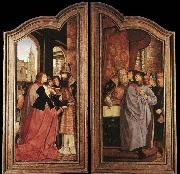 |
St Anne Altarpiece |
1507-08 Oil on wood, 220 x 92 cm (each wing) Musees Royaux des Beaux-Arts, Brussels The backs of the wings, when the triptych is closed, juxtapose two scenes. The first takes place beneath the portico of a church, the double arch of which gives onto a square, at the far end of which can be seen the tower of Antwerp cathedral. Under the portico, the High Priest of Jerusalem is receiving an ebony casket from St Anne, who lowers her eyes. Behind her, Joachim holds a parchment which contains the act of donation to the temple and its ministers. In the distance are two figures seen from behind: these too are Anne and Joachim, distributing money to the poor. In the second scene, Joachim's face and attitude express his distress and confusion: the High Priest has refused the coins Joachim has just placed on the offering table, and is gesturing to him brusquely to leave. Massys may sometimes tend towards mawkishness in his treatment of these themes, but St Anne was a particularly popular legend in Flanders and Holland, and this painting brought him immediate and considerable success. , Artist: MASSYS, Quentin , St Anne Altarpiece (closed) , 1451-1500 , Flemish , painting , religious |
| 64560 |
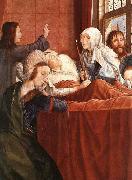 |
St Anne Altarpiece |
1507-08 Oil on wood Mus?es Royaux des Beaux-Arts, Brussels The right wing shows St Anne on her death bed, covered with a red sheet, her face pale, her mouth half open, as if she had just breathed her last. Mary Salome, who has collapsed with grief, wipes the tears from her cheeks. Artist:MASSYS, Quentin Title: St Anne Altarpiece (right wing, detail), 1451-1500, Flemish , painting , religious |
| 8095 |
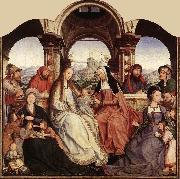 |
St Anne Altarpiece (central panel) g |
1507-08
Oil on wood, 224,5 x 219 cm
Mus??es Royaux des Beaux-Arts, Brussels |
| 8096 |
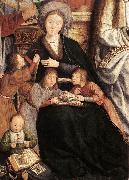 |
St Anne Altarpiece (detail) rfg |
1507-08
Oil on wood
Mus??es Royaux des Beaux-Arts, Brussels |
| 8097 |
 |
St Anne Altarpiece (right wing, detail) eh |
1507-08
Oil on wood
Mus??es Royaux des Beaux-Arts, Brussels |
| 8094 |
 |
St Anne Altarpiece sg |
1507-08
Oil on wood, 224,5 x 219 cm (centre), 220 x 92 cm (each wing)
Mus??es Royaux des Beaux-Arts, Brussels |
| 8112 |
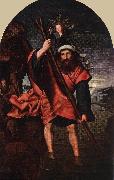 |
St Christopher sh |
Oil on wood
Koninklijk Museum voor Schone Kunsten, Antwerp |
| 32405 |
 |
St John Altarpiece |
1507-08
Oil on wood, 260 x 504 cm |
| 64221 |
 |
St John Altarpiece |
1507-08 Oil on wood Koninklijk Museum voor Schone Kunsten, Antwerp The monumental triptych welds together 15th century tradition and the new ideas about art which were emerging from Italy. The light effects, the gradation of colour and the interweaving of the composition hark back to the attention to detail, the use of landscape as a backdrop and the rather stereotypical figures of the previous century. , Artist: MASSYS, Quentin , St John Altarpiece (detail) , 1451-1500 , Flemish , painting , religious |
| 8099 |
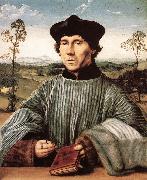 |
St John Altarpiece (central panel) g |
1507-08
Oil on wood
Koninklijk Museum voor Schone Kunsten, Antwerp |
| 8102 |
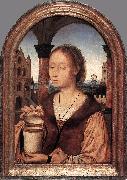 |
St John Altarpiece (detail) g |
1507-08
Oil on wood
Koninklijk Museum voor Schone Kunsten, Antwerp |
| 8100 |
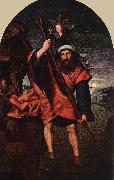 |
St John Altarpiece (left wing) sg |
1507-08
Oil on wood
Koninklijk Museum voor Schone Kunsten, Antwerp |
| 8101 |
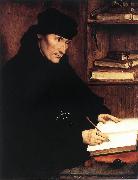 |
St John Altarpiece (right wing) dh |
1507-08
Oil on wood
Koninklijk Museum voor Schone Kunsten, Antwerp |
| 8098 |
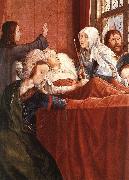 |
St John Altarpiece dfh |
1507-08
Oil on wood, 260 x 504 cm
Koninklijk Museum voor Schone Kunsten, Antwerp |
| 63974 |
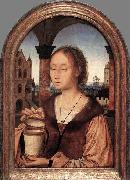 |
St Mary Magdalene |
45 x 29 cm Koninklijk Museum voor Schone Kunsten, Antwerp Quentin Massys was the first major artist of the rising Antwerp school in the 16th century. In his refined Saint Mary Magdalene, the artist conveys his ideal of feminine beauty in masterly fashion. , Artist: MASSYS, Quentin , St Mary Magdalene , 1451-1500 , Flemish , painting , religious |
| 32395 |
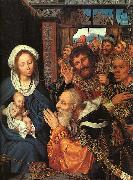 |
The Adoration of the Magi |
1526
Tempera and oil on wood |
| 8103 |
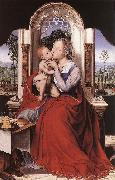 |
The Adoration of the Magi dh |
1526
Tempera and oil on wood
Metropolitan Museum of Art, New York |
| 33533 |
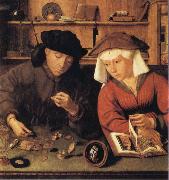 |
The Money-changer and his Wife |
mk86
1514
Oil on wood
70x67cm
Paris,Musee National du Louvre
|
| 8108 |
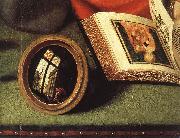 |
The Moneylender and his Wife (detail) sdg |
1514
Oil on panel
Mus??e du Louvre, Paris |
| 8109 |
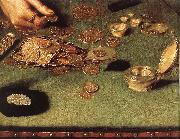 |
The Moneylender and his Wife (detail) sg |
1514
Oil on panel
Mus??e du Louvre, Paris |
| 8107 |
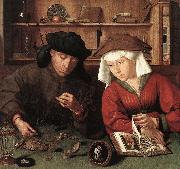 |
The Moneylender and his Wife sg |
1514
Oil on panel, 71 x 68 cm
Mus??e du Louvre, Paris |
| 8114 |
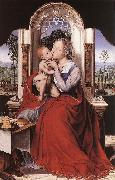 |
The Virgin Enthroned sg |
c. 1525
Oil on wood, 135 x 90 cm
Staatliche Museen, Berlin |
| 63979 |
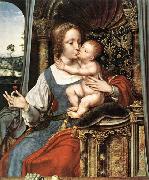 |
Virgin and Child |
The Hague , Artist: MASSYS, Quentin , Virgin and Child , 1451-1500 , Flemish , painting , religious |
| 63980 |
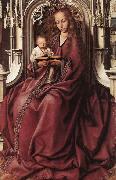 |
Virgin and Child |
130 x 86 cm Musees Royaux des Beaux-Arts, Brussels The Virgin is seated in three-quarter profile on an imposing stone throne with Gothic ornamentation. Richly dressed in a dark red, fur-lined gown and a mantle bordered with pearl braiding, her head inclined in recollection, she holds the infant Jesus on her right arm. She appears to be meditating a passage in the book that Christ is thumbing. Their faces are surrounded by halos of golden rays. The Child, in a long white shirt, has seized the bookmark. Through an open window to the right of the throne we glimpse a building on the other side of a courtyard. The upper part of the window is decorated with a stained glass panel depicting St Catherine flanked by two escutcheons. A similar stained glass window to the left carries the figure of St Barbara. This painting, attributed to Quentin Massys, is part of the Madonna with Child group that the artist painted during his youth. The symmetrical composition, the hieratic presentation of the figures, the style of the Virgin's garments and the vigorous modelling of the draperies as well as the Gothic ornamentations all recall the tradition of the Flemish Primitives. The iconographic theme picks up the traditional image of Christ's incarnation. The Virgin in majesty is directly associated with the divine nature of her Son, the Word incarnate. Her meditative attitude and the red of her garments evoke the presentiment she had of her Child's destiny right from his birth. Massys' work refers back to earlier compositions that present Christ reading in the Virgin's arms. Two famous examples are Rogier van der Weyden's Madonna Duren (Madrid, Prado) and the Ince Hall Virgin attributed to a follower of Jan van Eyck (Melbourne, National Gallery of Victoria). With Massys we have the same monumental pose of the Virgin, with the niche-shaped throne similar to the one in Van der Weyden's painting. Even if the Brussels Madonna with Child shows how much the painter was part of the Flemish tradition, before coming under the influence of the Renaissance, it already contains the novel elements that were to make Massys the captivating and highly innovative artist whose talent would be fully revealed in his later works. With his exceptionally ample volumes, his supple shapes caressed by a strong, yet soft light, and the virtuoso translucency of his colouring technique, he carries the art of modelling forward to new heights. , Artist: MASSYS, Quentin , Virgin and Child , 1451-1500 , Flemish , painting , religious |
| 63978 |
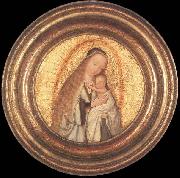 |
Virgin with the Child |
22,5 cm Rockox House, Antwerp Around 1500, when the port of Antwerp began to emerge as the capital of north European trade, it also became a cultural melting pot. All manner of artists flocked into the town on the Scheldt. One of these was Quentin Massys from Louvain, who registered as a painter in the St. Lucas Guild in 1491, and is regarded as the founder of the Antwerp School which was soon to topple the hegemony of the School of Bruges. He remained faithful to the Flemish tradition, although the sfumato in the background of some of his landscapes shows that he was familiar with the work of Leonardo da Vinci. He is usually regarded as a painter of monumental works, and rightly so, but he also painted smaller scale scenes with figures. This is hardly surprising, since his technique had its sources in miniature paintings. The Holy Virgin with the Child Jesus, a small tondo, bears witness to the attention the master paid to sensitive, finely detailed drawing to express the tender movement of the form, and the subtle use of colour to convey the essence of a variety of textures. , Artist: MASSYS, Quentin , Virgin with the Child , 1451-1500 , Flemish Form |
|
|
| MASSYS, Quentin
|
| Flemish Northern Renaissance Painter, ca.1465-1530
Quentin Massys, also spelled Matsys or Metsys, was born in Louvain, the son of a blacksmith. He is traditionally thought to have been trained in that craft by his father. Art in Louvain while Massys was growing up was dominated by Dirk Bouts. Massys became a member of the painters' guild in Antwerp in 1491 and died there in 1530. He represented a current of painting that flourished in Antwerp at this time of its sudden new prosperity. Erwin Panofsky (1953) described this trend, "archaism of around 1500," as "a prelude to, in fact a fact of, the Renaissance in Netherlandish painting," which prevailed in the southern Netherlands. The monumental Enthroned Madonna (Brussels), an early work by Massys, has features recalling both Robert Campin and Jan van Eyck. The central panel of Massys' imposing St. Anne Altarpiece, or the Holy Kinship (Brussels), which was commissioned for the church of St-Pierre in Louvain in 1507 and signed and dated 1509, has a prototype in the Holy Kinship of Geertgen tot Sint Jans. Even the physical types and costumes in Massys' version refer to Geertgen's. But Massys placed his rhythmically balanced figure groups in a domed, arcaded loggia that in architectural style appears to be reaching for a Renaissance vocabulary it cannot quite attain; certainly the architecture evokes a later period than that represented by the Gothic throne of the Enthroned Madonna. The calm and restraint of the St. Anne Altarpiece are replaced by heightened emotional expression in the next important painting by Massys that can be firmly dated, the Deposition triptych (Antwerp). This was commissioned in 1508 by the guild of joiners in Antwerp for their chapel in the Cathedral; Massys completed the composition in 1511. It was inspired by Rogier van der Weyden's great Deposition, which was in the church of St-Pierre in Louvain in Massys' time, and also quotes from Rogier's Entombment. Massys painted genre subjects, possibly with emblematic meaning, such as A Money Changer and His Wife, which belonged to a Netherlandish tradition that maintained its popularity right through the 17th century. In portraiture he made significant contributions. His pair of portraits of Erasmus and Petrus Aegidius, painted in 1517 for Sir Thomas More, set the pattern for representations of the scholar in his study.
|
|

